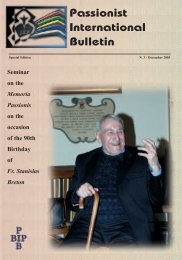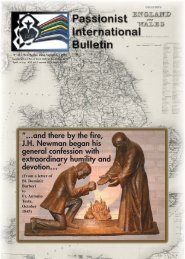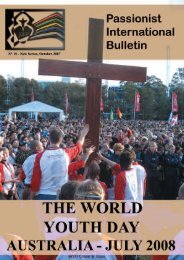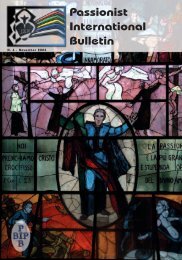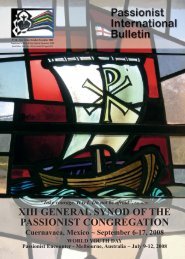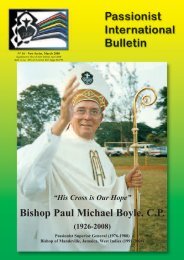Passionist International Bulletin
Passionist International Bulletin
Passionist International Bulletin
- No tags were found...
Create successful ePaper yourself
Turn your PDF publications into a flip-book with our unique Google optimized e-Paper software.
The Curia InformsA SPECIAL PASSIONIST APOSTOLATEIN THE PRISONS OF ROME DURINGTHE 18TH CENTURYFr. Fabiano Giorgini, C.P.Fr. Paulino Alonso, C.P.18The Roman prisons of the 18th century were characterizedby good, stable organization thanks tovarious state institutions and to Christian confraternitieswho offered material and spiritual assistanceto the incarcerated. Those in charge of pastoralministry frequently chose the <strong>Passionist</strong>s asretreat preachers.The Superiors General chose these religiousfrom the Roman communities of Sts. John andPaul and the Scala Santa. There were almostalways two priests - sometimes four -- each designatedto different groups and different places.When necessary, confessors were also added.Usually they preached twice a day: a meditationon the Passion and then some kind of catechesis.The <strong>Passionist</strong>s were always aware that their ministrywas in collaboration with the prison ministryand they sought to offer to the detainees the mostconvenient means for doing penance and forreturning to a moral and Christian lifestyle.Encouraging all to go to Confession andCommunion was the ultimate goal and the criteriafor measuring the successfulness of the retreat.The Hospice of "San Michele A Ripa"The Hospice of St. Michael, which during the1800's encompassed four branches: elderly men,elderly women, boys and girls, was established on20 May 1693 and was located in theTrastevere section of Rome near thecentral banks of the Tiber River,called the "Ripagrande". In 1703,Pope Clement XI instituted a reformatoryfacility to correct the vices ofunderage offenders and for thosefound guilty of petty crimes. It wascalled: "St. Michael's for delinquents".Pope Clement XII (1730-1740) erected a correctional facilityfor women involved in prostitution towhich were also added those whowere found guilty of crimes againstthe common good. Pius VIII (1829-1830) used the buildings provided byVen. Fr. Norberto Cassinelli, C.P.Clement XI and Clement XII to form a singleinstitution for incarcerated women called the "St.Michael's House for the guilty" . Sometimes thenumber in this facility reached 250 and they weredivided into three classes: those who had committedcrimes against the common good, those whowere first-time offenders and those who werehabitual offenders.A pious union of priests, founded in 1838, wasentrusted with the pastoral care of the entireestablishment. A prelate, the "chierico di camera",possessing all the necessary and opportune faculties,directed the spiritual dimension of the establishmentand also cared for material matters. Oneof these prelates was the future Pope Pius IX. Thehospice was declared a parish by Leo XII (1823-1829).In addition to the apostolic ministry undertakenby the <strong>Passionist</strong>s on behalf of groups of elderlymen and women, boys and girls from 1840 to1886 there were also four triduums and fourretreats that were preached to those sentenced,including eight retreats to young men and fourretreats to young women.The New PrisonsThe massive edifice of the New Prisons, foundon Via Giulia, also called the "innocenziane"because they were begun byInnocent X (1644-1655), werepraised for their consistency, securityand internal order. In 1828, theyoung men and under-age boys thatwere found guilty or in need of disciplinaryattention were transferredby Leo XII to the hospice of St.Michael.From 1854 to 1890 the <strong>Passionist</strong>spreached 19 week-long retreats inthe prisons and four three-dayretreats. During the years 1860-1861 Fr. Pio Cayro, GeneralConsultor, preached on various



